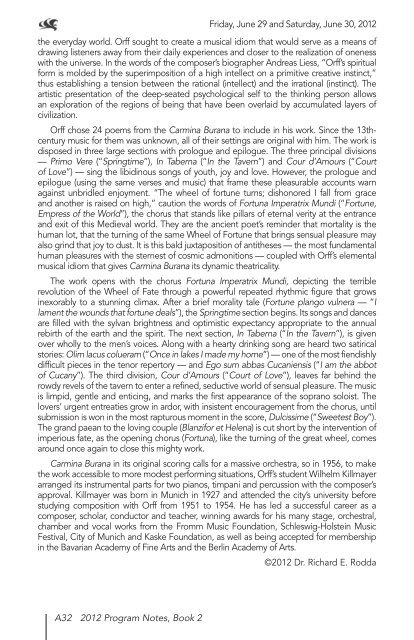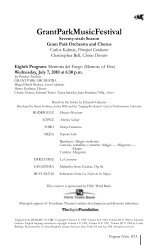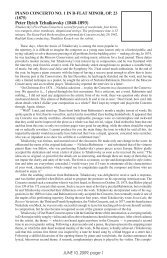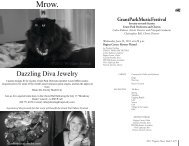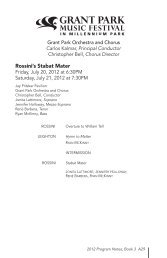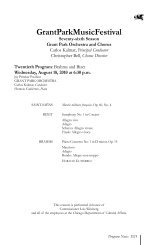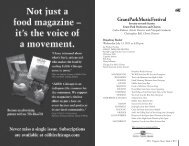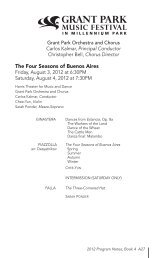Golden Anniversary Choral Spectacular - The Grant Park Music ...
Golden Anniversary Choral Spectacular - The Grant Park Music ...
Golden Anniversary Choral Spectacular - The Grant Park Music ...
You also want an ePaper? Increase the reach of your titles
YUMPU automatically turns print PDFs into web optimized ePapers that Google loves.
A32 2012 Program Notes, Book 2<br />
Friday, June 29 and Saturday, June 30, 2012<br />
the everyday world. orff sought to create a musical idiom that would serve as a means of<br />
drawing listeners away from their daily experiences and closer to the realization of oneness<br />
with the universe. In the words of the composer’s biographer Andreas Liess, “orff’s spiritual<br />
form is molded by the superimposition of a high intellect on a primitive creative instinct,”<br />
thus establishing a tension between the rational (intellect) and the irrational (instinct). <strong>The</strong><br />
artistic presentation of the deep-seated psychological self to the thinking person allows<br />
an exploration of the regions of being that have been overlaid by accumulated layers of<br />
civilization.<br />
orff chose 24 poems from the Carmina Burana to include in his work. Since the 13thcentury<br />
music for them was unknown, all of their settings are original with him. <strong>The</strong> work is<br />
disposed in three large sections with prologue and epilogue. <strong>The</strong> three principal divisions<br />
— Primo Vere (“Springtime”), In Taberna (“In the Tavern”) and Cour d’Amours (“Court<br />
of Love”) — sing the libidinous songs of youth, joy and love. However, the prologue and<br />
epilogue (using the same verses and music) that frame these pleasurable accounts warn<br />
against unbridled enjoyment. “<strong>The</strong> wheel of fortune turns; dishonored I fall from grace<br />
and another is raised on high,” caution the words of Fortuna Imperatrix Mundi (“Fortune,<br />
Empress of the World”), the chorus that stands like pillars of eternal verity at the entrance<br />
and exit of this Medieval world. <strong>The</strong>y are the ancient poet’s reminder that mortality is the<br />
human lot, that the turning of the same Wheel of Fortune that brings sensual pleasure may<br />
also grind that joy to dust. It is this bald juxtaposition of antitheses — the most fundamental<br />
human pleasures with the sternest of cosmic admonitions — coupled with orff’s elemental<br />
musical idiom that gives Carmina Burana its dynamic theatricality.<br />
<strong>The</strong> work opens with the chorus Fortuna Imperatrix Mundi, depicting the terrible<br />
revolution of the Wheel of Fate through a powerful repeated rhythmic figure that grows<br />
inexorably to a stunning climax. After a brief morality tale (Fortune plango vulnera — “I<br />
lament the wounds that fortune deals”), the Springtime section begins. Its songs and dances<br />
are filled with the sylvan brightness and optimistic expectancy appropriate to the annual<br />
rebirth of the earth and the spirit. <strong>The</strong> next section, In Taberna (“In the Tavern”), is given<br />
over wholly to the men’s voices. Along with a hearty drinking song are heard two satirical<br />
stories: Olim lacus colueram (“Once in lakes I made my home”) — one of the most fiendishly<br />
difficult pieces in the tenor repertory — and Ego sum abbas Cucaniensis (“I am the abbot<br />
of Cucany”). <strong>The</strong> third division, Cour d’Amours (“Court of Love”), leaves far behind the<br />
rowdy revels of the tavern to enter a refined, seductive world of sensual pleasure. <strong>The</strong> music<br />
is limpid, gentle and enticing, and marks the first appearance of the soprano soloist. <strong>The</strong><br />
lovers’ urgent entreaties grow in ardor, with insistent encouragement from the chorus, until<br />
submission is won in the most rapturous moment in the score, Dulcissime (“Sweetest Boy”).<br />
<strong>The</strong> grand paean to the loving couple (Blanzifor et Helena) is cut short by the intervention of<br />
imperious fate, as the opening chorus (Fortuna), like the turning of the great wheel, comes<br />
around once again to close this mighty work.<br />
Carmina Burana in its original scoring calls for a massive orchestra, so in 1956, to make<br />
the work accessible to more modest performing situations, orff’s student Wilhelm Killmayer<br />
arranged its instrumental parts for two pianos, timpani and percussion with the composer’s<br />
approval. Killmayer was born in Munich in 1927 and attended the city’s university before<br />
studying composition with orff from 1951 to 1954. He has led a successful career as a<br />
composer, scholar, conductor and teacher, winning awards for his many stage, orchestral,<br />
chamber and vocal works from the Fromm <strong>Music</strong> Foundation, Schleswig-Holstein <strong>Music</strong><br />
Festival, City of Munich and Kaske Foundation, as well as being accepted for membership<br />
in the Bavarian Academy of Fine Arts and the Berlin Academy of Arts.<br />
©2012 Dr. Richard E. Rodda


